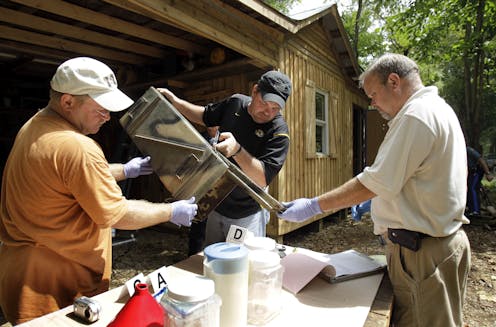
Police detectives sort through evidence after raiding a suspected meth lab. AP Photo/Jeff Roberson
Rural America has long suffered from an epidemic of methamphetamine use, which accounts for thousands of drug overdoses and deaths every year.
William Garriott, an anthropologist at Drake University, explored meth’s impact on communities and everyday life in the U.S. in his 2011 book “Policing Methamphetamine: Narcopolitics in Rural America.” Since then, the problem has only gotten worse.
The rural news site the Daily Yonder spoke with Garriott about what has been driving the surge in meth use in recent decades and what prompted him to focus on meth in his work. The Conversation has collaborated with The Daily Yonder to share the interview with you.
How’d you get interested in methamphetamine as an academic subject?
When I started my Ph.D in anthropology in 2003, I knew I wanted to focus on the Appalachian region of the United States. At the time, I was curious about religious life in the region and its contribution to the growth of Pentecostalism and evangelicalism around the world.
But I had also just taken a course with medical anthropologist Arthur Kleinman. He says that we should seek to understand “what’s at stake” or “what really matters” for people in their everyday lives.
And what really mattered to people in places like eastern Kentucky at the time was drugs. We now know we were at the beginning of the opioid epidemic. OxyContin was already taking a toll on local communities, and there was little national concern because it was seen as an isolated regional problem (the derogatory term “hillbilly heroin” was getting thrown around a lot at the time).
When I started my dissertation research, methamphetamine had become the primary concern, both regionally and nationally. When the Patriot Act was reauthorized in 2005, the only significant addition was anti-meth legislation called the Combat Meth Epidemic Act.
In what sense was the meth surge of the ’90s and early 2000s a rural phenomenon?
Lots of ways. The internet gave people access to meth recipes, and meth cooks tended to be located in rural areas. It was easier to hide and access key ingredients like anhydrous ammonia. In fact, the number of meth labs grew so quickly that huge swaths of the rural U.S. were labeled High Intensity Drug Trafficking Areas – something that had only been applied to cities like New York and Los Angeles before.
The rural economy was also changing. Jobs weren’t paying as well or were going away altogether. Meth found a niche as a kind of performance enhancement drug for people working long hours at physically demanding jobs – something I saw in the poultry industry in West Virginia, journalist Nick Reding found in the pork industry in Iowa, and anthropologist Jason Pine found in general in Missouri. Eventually some folks just left these jobs to work in the meth economy full time.
I think it’s also important to mention how meth was being portrayed in national media as the drug of choice for poor white people. From there, it doesn’t take much to connect it to rural communities, given how those communities are often thought of as predominantly white and poor in the public imagination.
Anti-meth programs like the Montana Meth Project and Faces of Meth played a big part in this. They were very visual campaigns that focused on the damage meth does to the body. All of the people they pictured appeared to be white. They had sores, scars and sunken eyes. They also were often missing teeth. All of that invokes a lot of stereotypes. Sociologists Travis Linnemann and Tyler Wall have a great journal article on this.
With all of that said, it is important to keep in mind that meth is just as much an urban and suburban problem as a rural one, particularly now. Sociologist Miriam Boeri has made this point really clearly. Also, something to keep in mind about Faces of Meth: It was created by a jail deputy in Oregon who used mugshots of people booked into the county jail. The jail is in Portland, so the folks featured probably weren’t living in rural communities at the time.
Your book was called “Policing Methamphetamine.” I’m curious – what made you zero in on that element of meth culture, its policing?
When I began my research, I thought my focus would be on the treatment experiences of people who use methamphetamine. But what I quickly found was that those experiences couldn’t be understood outside of the criminal justice system. Many people only got treatment after an arrest, and often as a condition of probation. One officer told me that people came up to him on the street and asked to be taken to jail so they could stop using drugs. Community members also often channeled their concerns into calls for increased enforcement.
In retrospect, none of this should have been surprising. U.S. drug policy has long focused on enforcement. This puts police and the criminal justice system on the front lines whenever and wherever a new drug problem emerges. There is no exception to this dynamic for rural communities. What’s more, the justice system is likely to be the most visible and well-resourced state institution in the community (which is not to say it is sufficiently resourced).
What are the questions you still have about meth in American life?
Today, the most pressing question from my perspective is how meth and opioids are converging. One of the more unfortunate developments is that people have started injecting meth. There is also the broad contamination of the drug supply with fentanyl.
All of this creates additional public health challenges, particularly in rural communities.
Something else I’m thinking about a lot is what happens when drugs like meth stop making headlines and get replaced by the next drug scourge. Today, people are much more likely to talk about fentanyl than meth. This is understandable given the overdose risks, as well as the way news media works. But what are the consequences of this for the communities where meth is still a major concern?
Bigger picture, I’m thinking about meth in the broader context of U.S. drug policy. My next book is about marijuana legalization and justice reform. It’s been interesting because the conversation around cannabis is so different from the conversation around meth. One of the big questions I have is if the kinds of reforms that are following cannabis legalization will do anything to change the conversation around the broader punitive approach to drugs. The debate happening right now in Oregon over Measure 110 is something I’m watching very closely. It’s a major test case for whether or not a different, less punitive approach to drugs is possible.
The Daily Yonder provides news, commentary and analysis about and for rural America. The interview accompanies a five-part series on its Rural Remix podcast.
Advertisement

Advertisement
Contact Us
If you would like to place dofollow backlinks in our website or paid content reach out to info@qhubonews.com











